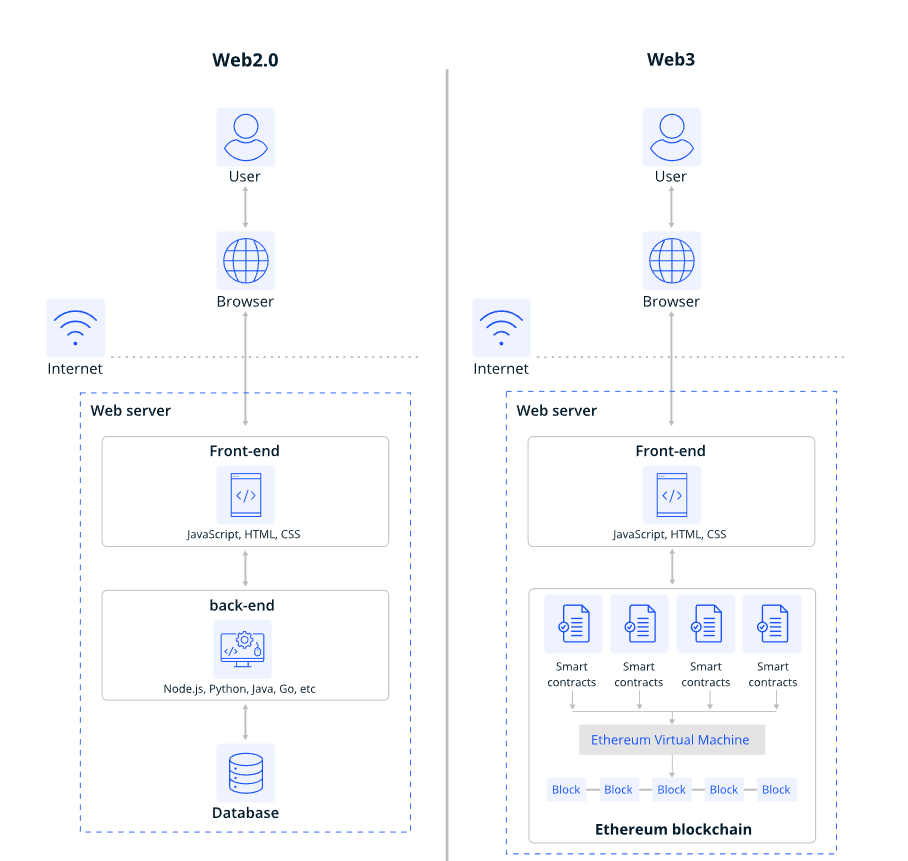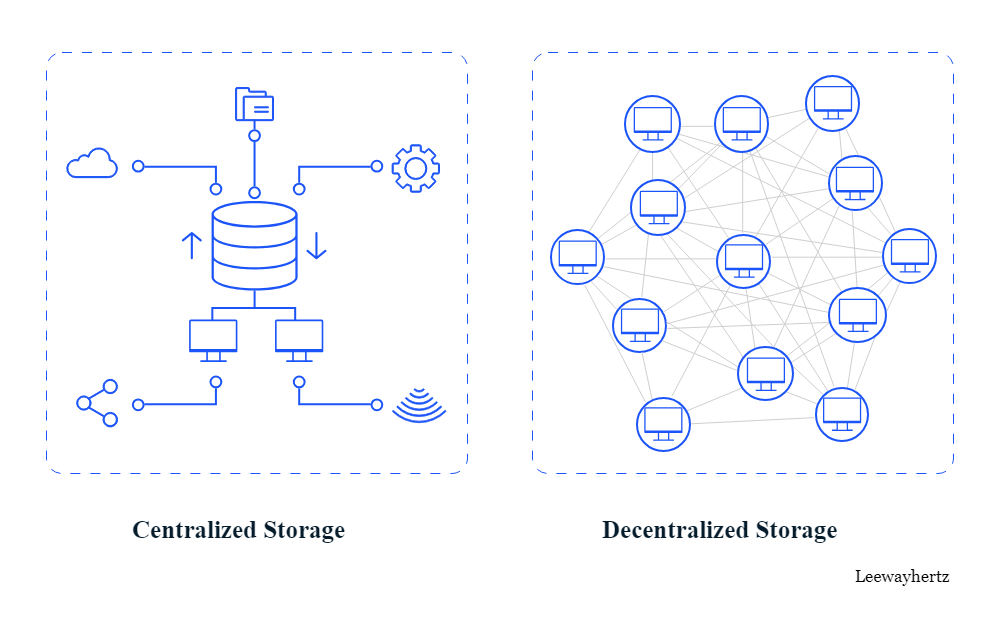Logics to consider while migrating from web2 to web3
-

While migrating an application from web2 to web3, the following aspects should be considered:
Data storage method
We might use peer-to-peer solutions in a web3 technology stack just like we would a database in a traditional stack. However, in web3, we use blockchain technology where data is replicated across n number of nodes on a decentralized, more reliable network. Blockchain technology is not the same as a database. It stores some data, but it’s mostly transaction metadata. Also, web3 applications differ from web2 applications because they have different data architectures. Web3 applications use a user-centric data storage model. This model stores application data on a distributed network and allows users to access it. Applications can also query and write to the data client side. This is in contrast to web2 applications, which are application-centric and store all data related to an application on a single server.

Building web3 data apps is therefore possible only by using a few basic primitives:
- Network for fast data availability and mutability via a decentralized network
- Protocol for model-based, identity-centric data storage/retrieval
- Client to perform CRUD operations in users’ stores at runtime.
So, in web2 to web3 data migration
- Need to migrate from simple data storage method to decentralized(using blockchain) data storage method.
- On web3, storage data ownership always belongs to the user, unlike centralized data storage, where user data is used for personal gain.
- On web3, data can not be altered or removed so the security and immutability of data keep intact.
Instead of API/network calls to send/receive data, you will have to query blockchain using smart contracts.
Wallet/Payment migration
In web2 to web3 migration, users must migrate from simple payment gateway to crypto wallet as web3 uses decentralized currency. Web3 wallets provide a gateway to many blockchain-based crypto apps, Decentralized Finance (DeFi), gaming and nonfungible tokens. These applications can be accessed via a desktop browser. In this case, many processes run in the background, and the browser will notify the user of any sharing activity. Metamask, one of the most well-known web3 wallets, is a popular choice.
Users can also use third-party wallet libraries or APIs as per their requirements. As web3 transactions are done using cryptocurrency, the buy and sell flow in the application will be different than web2. In web2, a central authority like a bank controls transactions during selling and buying. On the contrary, in web3, it happens in a decentralized way. If the user wants to see the transaction listing or history, they need to fetch it from the blockchain.
What transactions need to be stored in web2 to web3 migration?
- Minting of Tokens – Whenever a user creates any token, we need to store those in web3 with all the details about its owner.
- Buy-sell/owner transfer of Tokens – Whenever a user buys or sells any tokens, that need to be stored with all the details of the previous owner and the current owner.
- Balance transfer from wallet to wallet – If any user transfers the balance to another user, that needs to be stored on the web3 with details of the sender, receiver and the amount transferred. i.e., any change which happens in the users’ wallet or user’s tokens.
What will be the changes in user flow in web2 to web3 migration?
Web3 means we digitally own content/tokens we share, mint and purchase on the platform. Hence, we have total control over our content/tokens. So, whenever we want to buy, sell, transfer and purchase with tokens, we have to interact with web3 with the help of a smart contract. So the user interaction will be very high than web2, as we have total control over our content.
Components that may help in web2 to web3 migration
Web3j is a highly modular, lightweight, reactive, type-safe Java and Android library that works with smart contracts and integrates with clients (nodes) on the Ethereum network.
Features
- Ethereum’s JSON-RPC client API is completely implemented over HTTP and IPC
- Support for Ethereum wallet
- Java smart contract wrappers auto-generation for creating, deploying, transacting with and calling smart contracts from native Java code (Truffle and Solidity definition formats supported)
- Reactive-functional API for working with filters
- Support for Parity’s Personal and Geth’s Personal client APIs
- Ethereum Name Service support
- Support for Alchemy and Infura, so you don’t have to run an Ethereum client yourself
- Comprehensive integration tests demonstrating a number of the above scenarios
- Command line tools
- Android compatible
- Support for Quorum via web3j-quorum
- Support for EEA privacy features. It is implemented in Hyperledger Besu.
Web and BackEnd SDKs
This is the Ethereum JavaScript API. The API connects to the Generic JSON -RPC specifications. We need to run an Ethereum node locally or remotely to use this library. Web3.js allows us to accomplish the responsibility of developing clients interacting with the Ethereum blockchain. It is an open-source JavaScript library made by the Ethereum Foundation and comprises functions to connect with an Ethereum node through the JavaScript Object Notation — Remote Procedure Call (JSON-RPC) protocol. It is a JavaScript library that enables developers to interact with the Ethereum blockchain. It is a collection of libraries and buildup of four modules that enable us to do activities like:
- Direct Ether from one account to another
- Deliver and write data from smart contracts
- Make smart contracts
End note
The underlying technical facilities of web3 are based on blockchain technology. Its unique characteristics are immutability, decentralized storage and information encryption. The main goal of migrating a web2 Application to web3 is not to make everyone a crypto trader or flip NFTs. Instead, web2 to web3 migration will redesign and rebuild web2 use cases to web3 versions. Users will get multiple benefits through the web2 to web3 migration, like high availability, compatibility, interoperability, scalability and improved user experience, to name a few. Not to mention, the services and applications in the web3 space allow users to control their data and obtain rewards with their non-custodial nature.

